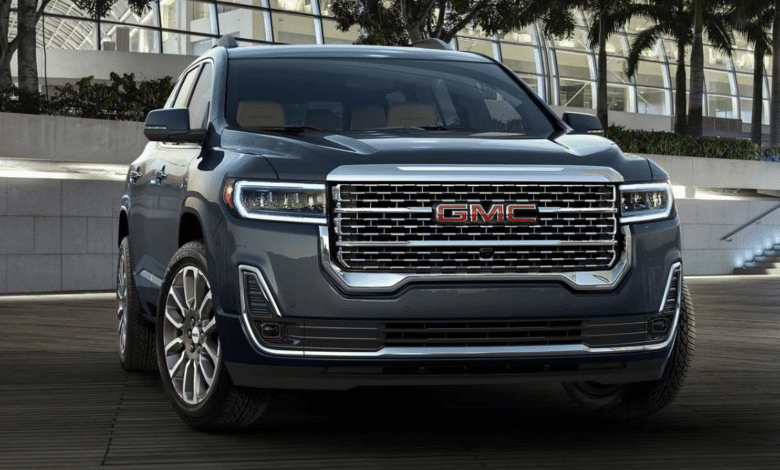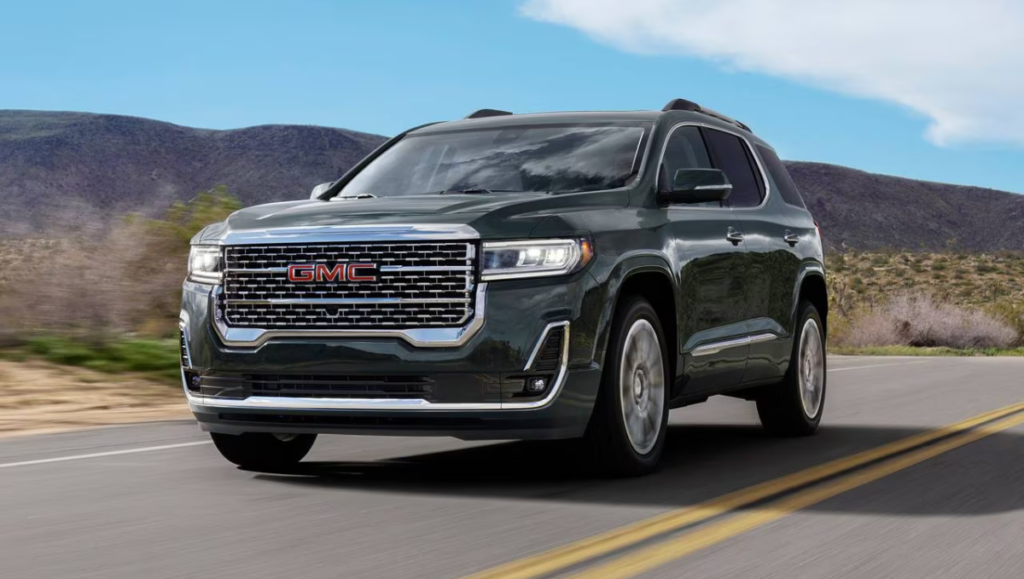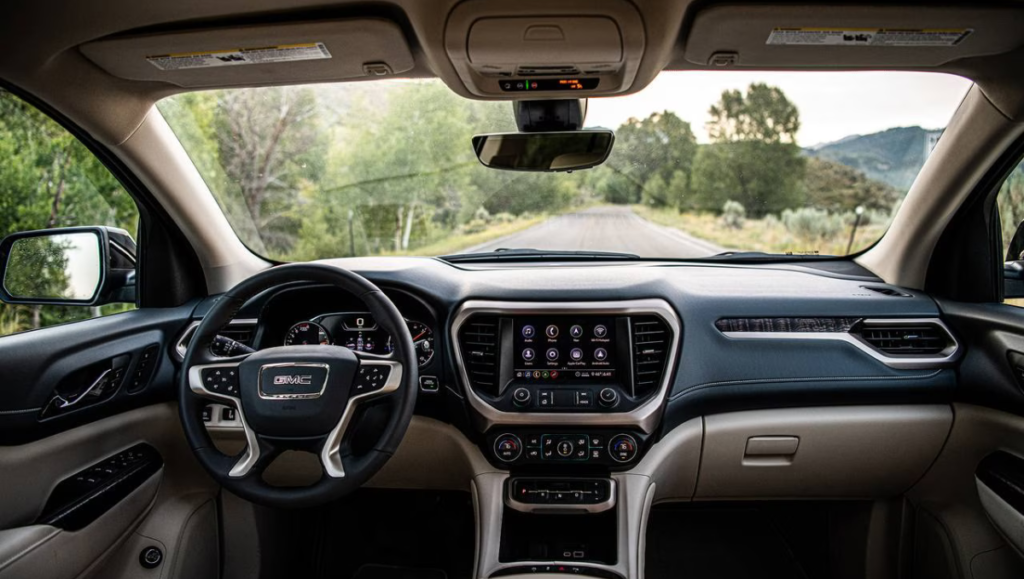
The GMC Acadia has been a well-liked option for families looking for a functional midsize three-row crossover since its launch in 2006. It offers a satisfying middle-of-the-road opportunity for individuals who want comfort and spaciousness but don’t want to upgrade to a more costly and powerful full-size SUV like the Yukon. A second-generation model debuted in 2017 with a sharper design and a smaller footprint to set it apart from the Cadillac XT6, Chevrolet Traverse, and Buick Enclave, three other platform relatives.
When the current Acadia reaches its sixth birthday later this year, it will be replaced by a new third-generation model. Following a mid-cycle redesign in 2020 and a few minor upgrades, the current Acadia is back with some new colours and a significant $2,000 price increase on all models. The remaining models are the all-terrain focused all-wheel drive-only AT4 ($44,795), the top-range Denali ($49,500), the mid-range SLT ($42,495), and the basic SLE ($38,690, with $1,395 delivery).
The Acadia soon falls short compared to the Kia Telluride, Hyundai Palisade, and the more recent Ford Explorer with rear-wheel drive in this crowded, competitive pricing range in value and driving manners. In addition, a new Honda Pilot has arrived. If the higher trim levels of the Acadia catch your eye, more luxurious models of the Jeep Grand Cherokee L, which has more capability, are also reasonably priced.
The 3.6-litre V6 engine in the Acadia and the 2.0-litre “Ecotec” four-cylinder engine from GM, which debuted with the 2020 redesign, power the front or all four wheels via a nine-speed automated transmission. All-wheel drive (AWD) is available for $2,300 on the SLE, $2,00 on the SLT, and $2,001 on the Denali. This heavy crossover is powered quite well by both engines, albeit the four-cylinder seems slightly underpowered. Like the Chevrolet Blazer, the V6 is the superior option; it also has a $495 upcharge and a negligible fuel efficiency penalty.

The Acadia is a trustworthy and respectable midsize vehicle that provides the correct amount of technology, comfort, safety, room, refinement, and adaptability for this market, doing the task without much drama or excitement. It isn’t that unique; more modern competitors provide more excellent value, amenities, and stylish looks. This is particularly true given that its asking price of $38,195 (plus a $1,395 destination fee) is $2000 more for the 2023 model year than for the 2024 model year.
GMC’s tried-and-true Acadia model is secure since its formula hasn’t altered in years. Because of its tastefully understated appearance, it stays out of sight, which is advantageous for its target market. Due to the pandemic and the wait for the new model, sales fell to less than half that of 2017. However, in 2017, it sold over 110,000 units. (General Motors provided the sales figures.) Still, the competition offers you a better deal overall. When the new 2024 Acadia is released in late 2023, we’re excited to see how it solves the value equation.
Performance: GMC Acadia
With a reported 0–60 time of an underwhelming eight seconds, the standard 2.0-litre Ecotec four-cylinder turbocharged engine’s 228 horsepower and 258 pound-feet of torque is barely enough to get the Acadia out of its way. With its 310 horsepower and 371 lb-ft of torque, the naturally aspirated 3.6-liter V6 is the recommended powerplant. Its six-second zero-to-60 time is much faster and more manageable.
In addition to having plenty of passing power, the V6’s linear power distribution produces much smoother acceleration, making driving considerably more enjoyable overall. It also sounds fantastic. If necessary, the four-cylinder Acadia can tow up to 3,300 pounds; when the optional trailering kit is used, the V6’s capability increases to 4,000 pounds.
The previous Acadia was a big, lumbering car that made little attempt to conceal its enormous size. Even though GM reduced the Acadia’s size for the current generation to set it apart from other vehicles on the same platform, this move also gave the car far better handling and agility. It controls itself well; it acts like a higher station wagon with more ground clearance and excellent body and suspension damping.
However, even with the optional AWD, don’t anticipate any true off-road capability; it won’t make for thrilling dinner talk. The Kia Telluride and the Ford Explorer with rear-wheel drive provide more thrilling driving experiences; if you’re looking for toughness, the Toyota 4Runner and Ford Bronco are superior options.

Fuel Efficiency: GMC Acadia
The front-wheel drive, four-cylinder 2023 Acadia is the most economical variant. It has a combined EPA rating of 25 mpg (22 city, 29 highway). Adding AWD is the modest cost of one mpg in the city and two mpg on the road.
It is to be anticipated that the V6 is less efficient, although not much. The front-wheel drive model’s combined fuel economy is 22 mpg (19 city, 27 highway); adding all-wheel drive reduces the combined and highway fuel economy by one mpg. The V6 is our choice because it’s smoother and more flexible functioning, especially considering the slight price increase at the pump.
These numbers barely differ by one or two mpg, which aligns them with most of the competition. With its highway fuel economy of 28 mpg, the four-cylinder, all-wheel-drive Ford Explorer is the lone contender to the Acadia in terms of efficiency. However, the hybrid Explorer and Toyota Highlander are your best options if you’re looking for a fuel-efficient three-row, all-wheel-drive midsize crossover.
Driver assistance and safety:
The second-generation Acadia, which debuted in 2017, has always had excellent safety technology, which continues improving as the vehicle ages. To maintain Acadia’s competitiveness, GMC standardized its Pro Safety Plus package on all models in 2022.
The complete suite includes automatic high beams, a following distance indicator, blind spot warning with lane-change alert, lane-departure warning with lane-keeping assistance, forward and rear collision warning with automated emergency braking and pedestrian detection. All models save the basic SLE and have an optional 360-degree surround-view parking camera. Those who want to pull a trailer may get the Trailering Package for a more complete rear-facing video system.
Throughout our week-long stay at the Acadia Denali, every system worked well. We found the front collision assist slightly overly sensitive, even though it was also the case with other GM models. This was especially noticeable when sudden lane changes occurred in the intense bumper-to-bumper NYC subway traffic. Some of the more recent competitors, especially those from Korea and Japan, have some more modern technology.
Coziness & Space:
The interior of the Acadia has consistently been quiet and offers cosy seats. All versions have a third row that can fit up to four people and two children and the typical second-row captain’s chair seating. Although it reduces personal space, an optional second-row seat allows one more passenger.
The Chevrolet Traverse is over a foot longer than the Acadia, with the lowest wheelbase and total length in the GM lineup. However, it still has a respectable amount of passenger capacity. There is ample 39.7 inches of legroom and 39.6 inches of headroom for second-row passengers, comparable to the Enclave, XT6, and even the Traverse. More erect competitors like the Telluride and Palisade in the back provide up to 42.4 inches of leg and 40.2 inches of headroom.
The length deficiency starts to show in the third row. With just 29.7 inches of legroom and 37.2 inches of headroom, adults who like experimenting with their pain tolerance should probably avoid this place. It is better suited for children. With 33.7 inches of legroom, the Volkswagen Atlas has the most helpful space for people in the third row if required. The Chevrolet Traverse is just a few tenths of an inch behind.

Infotainment: GMC Acadia
The infotainment system in the Acadia is mainly carried over from GM’s previous-generation unit because of the crossover’s age. The tried-and-true setup maintains the standard eight-inch colour touchscreen with Bluetooth, Android Auto, and wireless Apple CarPlay on all trim levels. Additionally optional are satellite navigation, Amazon Alexa, and a Wi-Fi hotspot.
The newest and best trucks and SUVs from the automotive behemoth GM use a unique technology that isn’t currently on the market. However, we anticipate it will come with the upcoming release of the third-generation Acadia, which is expected later this year.
Storage & Cargo Space:
The Acadia’s shortened length further impacts storage capacity. The Acadia has a 41.7 cubic foot cargo compartment behind the second seat. The cargo area decreases to 12.8 cubic feet when the third row is installed. Even the Jeep Grand Cherokee L has 17.2 cubes behind the third row and 46.9 cubes with the second row in place. However, the Chevy Traverse dominates this category with 57.8 cubic feet behind the second row when the third row is folded down and a considerably larger 23.0 cubic feet when the third set of seats is lifted.
However, the Traverse is so big that it almost seems like a full-size vehicle. The proportions of the VW Atlas are more similar to those of the Acadia. The most significant volume in the class, 55.5 cubic feet, is created when the third row of seats in the Atlas is folded. When both rows are folded, 96.8 cubes are accessible in the Atlas and 79.0 in the Acadia.
Design: GMC Acadia
The Acadia is a relatively advanced machine that isn’t too provocative or attention-grabbing thanks to its smooth, crease-free surfaces. Its general design is more akin to an elevated station wagon than a minivan, and its proportions are similar to those of the preceding model but with lower dimensions. It’s a solid, straightforward style doesn’t attempt to fool with needless decorative flourishes.
With its tiny wheels, roof rails, and tintless windows, the basic model undoubtedly has a rental fleet appearance. The improved alloys, tinted rear windows, and updated headlights make the SLE and Denali seem even more attractive. Conversely, the AT4 seems prepared for specific overlanding excursions, even if its restricted off-road capabilities might give the impression that it’s more show than function.
The cabin maintains the inoffensiveness with a straightforward, user-friendly design that avoids some other crossovers’ cluttered interiors with noticeably more buttons.

Is the 2023 GMC Acadia Worth it?
The standard 2.0-liter four-cylinder Acadia SLE with front-wheel drive begins at $38,690, including a $1,395 destination cost. AWD costs an extra $2,000 at least, and the V6—standard on the AT4 and available on the SLT and Denali—adds $495 if applicable. When you get the all-wheel-drive V6 Denali, which costs $51,995, including destination, and select all the boxes, you’ll be close to some high-end options. That is excessive for this.
The intermediate SLT ($42,195 including destination) with the $800 Preferred Package and the upgraded V6, which provides some further conveniences for not much extra cost, is our choice for the most significant value. With the latter, the Acadia is fitted with heated second-row seats, leather-wrapped power tilt and telescopic steering wheel, power heated and cooled front seats with memory settings for the driver, and all-around leather seating.
You’re at $45,490 with AWD. But because the all-new model is almost here, the $2,000 price rise for 2023 ruins the bargain a little bit. Prospective purchasers, however, may be able to take advantage of leftover inventory and get a great price on a moderately equipped vehicle or even a loaded Denali edition because a new third-generation Acadia is expected to arrive later this year.
How much does insurance for a GMC Acadia cost?
Regarding insurance prices, the GMC Acadia is comparable to its rivals. An average of $2,000 to $2,150 is what a 30-year-old female driver with a spotless record should anticipate paying. In particular, the AT4 costs less at $2,125 than the tip-trim Denali, which is around $2,139. The standard SE model of the Volkswagen Atlas costs around $1,906, while the SEL Premium R-Line costs $2,055. The Jeep Grand Cherokee L Altitude costs $2,034, and the Kia Telluride $1,919. The Chevrolet Traverse, its distant relative, costs around $1,972 for the Traverse LT and $2,026 for the High Country model.
GMC Acadia Generations
Second Generation
2018 to Present
For the 2018 model year, the second-generation GMC Acadia made its appearance. It was lighter and 7.2 inches shorter than its predecessor, weighing around 700 pounds. It could only carry seven passengers instead of eight. The second-generation Acadia used GMC’s new family-style approach and theme, carried over into the 2020 mild refresh. For 2020, a brand-new 2.0-litre four-cylinder turbocharged engine with a pushbutton gearbox was added.
First Generation
2007 to 2017
With the release of the Acadia, GMC produced its first car without a truck chassis. Despite being a three-row passenger car, it was introduced as a more economical and small-sized Yukon substitute.

Verdict
Except for new colours and a significant price increase, the second-generation GMC Acadia enters its last year of production with no modifications as the business prepares to launch a third-generation successor later this year. It is still a capable midsize three-row crossover that offers all the essential features in this market, including room, comfort, safety, and adaptability. But its roughly $2,000 price hike this year virtually eliminates its prior value offer. Individuals who want a reliable three-row crossover with a third row may use it sometimes; it’s a safe option. More recent and appealing possibilities exist, especially if you need more room, greater fuel efficiency, or flair.




